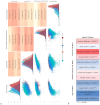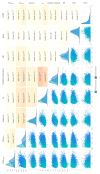The value of neck adipose tissue as a predictor for metabolic risk in health and type 2 diabetes
- PMID: 38552854
- PMCID: PMC7617930
- DOI: 10.1016/j.bcp.2024.116171
The value of neck adipose tissue as a predictor for metabolic risk in health and type 2 diabetes
Abstract
Upper-body adiposity is adversely associated with metabolic health whereas the opposite is observed for the lower-body. The neck is a unique upper-body fat depot in adult humans, housing thermogenic brown adipose tissue (BAT), which is increasingly recognised to influence whole-body metabolic health. Loss of BAT, concurrent with replacement by white adipose tissue (WAT), may contribute to metabolic disease, and specific accumulation of neck fat is seen in certain conditions accompanied by adverse metabolic consequences. Yet, few studies have investigated the relationships between neck fat mass (NFM) and cardiometabolic risk, and the influence of sex and metabolic status. Typically, neck circumference (NC) is used as a proxy for neck fat, without considering other determinants of NC, including variability in neck lean mass. In this study we develop and validate novel methods to quantify NFM using dual x-ray absorptiometry (DEXA) imaging, and subsequently investigate the associations of NFM with metabolic biomarkers across approximately 7000 subjects from the Oxford BioBank. NFM correlated with systemic insulin resistance (Homeostatic Model Assessment for Insulin Resistance; HOMA-IR), low-grade inflammation (plasma high-sensitivity C-Reactive Protein; hsCRP), and metabolic markers of adipose tissue function (plasma triglycerides and non-esterified fatty acids; NEFA). NFM was higher in men than women, higher in type 2 diabetes mellitus compared with non-diabetes, after adjustment for total body fat, and also associated with overall cardiovascular disease risk (calculated QRISK3 score). This study describes the development of methods for accurate determination of NFM at scale and suggests a specific relationship between NFM and adverse metabolic health.
Keywords: Adipose tissue; Cardiometabolic health; Fat distribution; Imaging; Neck; Type 2 diabetes mellitus.
Copyright © 2024 The Authors. Published by Elsevier Inc. All rights reserved.
Conflict of interest statement
Declaration of competing interest The authors declare that they have no known competing financial interests or personal relationships that could have appeared to influence the work reported in this paper.
Figures






Similar articles
-
Differential associations of somatic and cognitive-affective symptoms of depression with inflammation and insulin resistance: cross-sectional and longitudinal results from the Emotional Distress Sub-Study of the GRADE study.Diabetologia. 2025 Jul;68(7):1403-1415. doi: 10.1007/s00125-025-06369-8. Epub 2025 Feb 14. Diabetologia. 2025. PMID: 39951058 Free PMC article. Clinical Trial.
-
Comparison of Two Modern Survival Prediction Tools, SORG-MLA and METSSS, in Patients With Symptomatic Long-bone Metastases Who Underwent Local Treatment With Surgery Followed by Radiotherapy and With Radiotherapy Alone.Clin Orthop Relat Res. 2024 Dec 1;482(12):2193-2208. doi: 10.1097/CORR.0000000000003185. Epub 2024 Jul 23. Clin Orthop Relat Res. 2024. PMID: 39051924
-
Ablation of FAM210A in Brown Adipocytes of Mice Exacerbates High-Fat Diet-Induced Metabolic Dysfunction.Diabetes. 2025 Mar 1;74(3):282-294. doi: 10.2337/db24-0294. Diabetes. 2025. PMID: 39602358
-
Systemic pharmacological treatments for chronic plaque psoriasis: a network meta-analysis.Cochrane Database Syst Rev. 2021 Apr 19;4(4):CD011535. doi: 10.1002/14651858.CD011535.pub4. Cochrane Database Syst Rev. 2021. Update in: Cochrane Database Syst Rev. 2022 May 23;5:CD011535. doi: 10.1002/14651858.CD011535.pub5. PMID: 33871055 Free PMC article. Updated.
-
Nutritional interventions for survivors of childhood cancer.Cochrane Database Syst Rev. 2016 Aug 22;2016(8):CD009678. doi: 10.1002/14651858.CD009678.pub2. Cochrane Database Syst Rev. 2016. PMID: 27545902 Free PMC article.
Cited by
-
The Interplay between Liver and Adipose Tissue in the Onset of Liver Diseases: Exploring the Role of Vitamin Deficiency.Cells. 2024 Sep 30;13(19):1631. doi: 10.3390/cells13191631. Cells. 2024. PMID: 39404394 Free PMC article. Review.
-
Association Between Neck-to-Limb Length Ratio and Cardiovascular Events in a Chinese Population.Diabetes Metab Syndr Obes. 2025 Aug 13;18:2863-2872. doi: 10.2147/DMSO.S543163. eCollection 2025. Diabetes Metab Syndr Obes. 2025. PMID: 40827124 Free PMC article.
References
Publication types
MeSH terms
LinkOut - more resources
Full Text Sources
Medical
Research Materials

